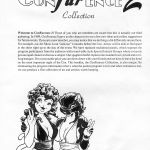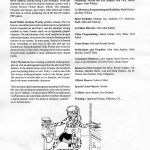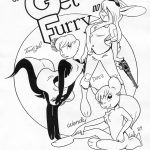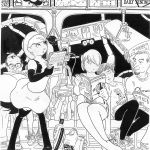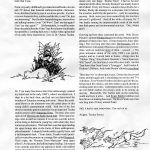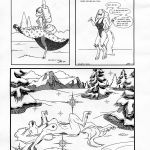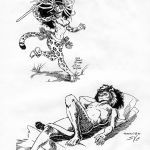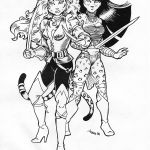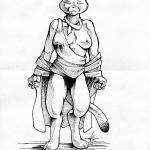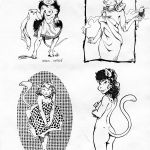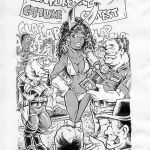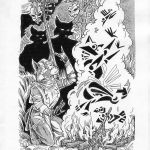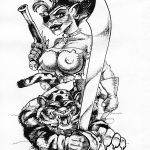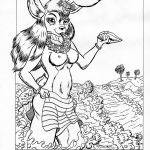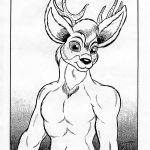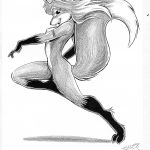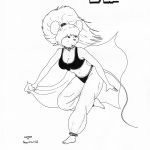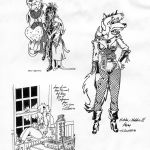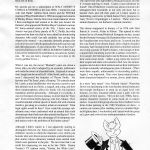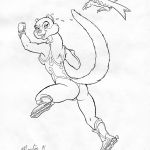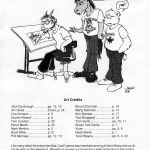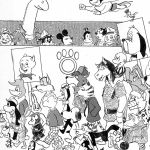Welcome to ConFurence 2! Those of you who are members are aware that this is actually our third gathering. In 1989, ConFurence 0 gave us the chance to try out a few new ideas and collect suggestions for future events. If you are a new member, you may notice that we do things a bit differently around here. For example, our Art Show is not “sold out” 4 months before the Con. Artists will be able to find space in the show right up to the day of the event. We have replaced traditional panels, which separate the program participants from the audience with round-table style Special Interest Groups where everyone gets an equal chance to discuss a subject. Our spaghetti buffet replaces the standard over-priced and over- long banquet. For a reasonable price you can chow down with your friends and not have to leave the hotel on the most important night of the Con. This booklet, the ConFurence Collection, is also unique. By eliminating the program information (that’s what the pocket program is for) and other extraneous text, we can produce a fine collection of art and articles worth keeping.
This year, ConFurence welcomes our first Guests of Honor; four people who have set the standards for modem Anthro¬ pomorphic entertainment.
Steve Gallacci, besides being a fine illustrator, wrote and published one of the first animal character comics with a serious Science Fiction theme, Albedo. His company, Thoughts and Images , gave many other artists and writers their start, as well as producing one of the best SF-Anthro. FRP games.
Reed Waller and Kate Worley produce Omaha. The Cat Dancer, one of the most controversial comics ever produced. Reed’s beautiful art and Kate’s real-life dramatic writing combine to make Omaha stand out as legitimate graphic literature. The adult themes of the work, handled in an open and honest manner, havedrawn fire from the fundamentalist factions in our country. In some areas, Omaha is a Banned book, reminding us that even in this day and age our freedoms are being threatened. Kate Worley also writes for the new Disney Comics titles, bringing a level of story quality not previously available to more traditional funny animal media.
Vicky Wyman has been creating wonderful Anthropomor¬ phic art with an adult appeal long before the advent of Furry fandom. In the limited series comic Xanadu, she revealed a great storytelling ability as well. Vicky’s work is one of the first serious Anthropomorphic works in the fantasy genre. Her universe is as believable as it is fantastic, and is popu¬ lated with many memorable characters.
TherearemanyotherimportantguestsattendingConFurence Special Guest Mascot: Omaha this year, far too many to mention here, so be sure to look for the “guest” ribbons. You never know WHO you mightmeet. ConFurence is our convention, and we’re all here because of a shared passion. Don’t be afraid to introduce yourself…
ConFurence 2 is brought to you by…
Our Guests: Steve Gallacci, Reed Waller, Kate Worley, Vicky Wyman, Jim Groat, Bill Fitts, Steve Martin, Lex Nakashima, Nicolai and Kay Shapero, Edd Vick, Martin Wagner, Deal Whitley
Co-Directors, Programming and Facilities: MarkMerlino and Rod O’Riley
Hotel Facilities: Holiday Inn, Anaheim, CA. Katherine Radd, Sales and Catering
Art Show Director: John Alan Stanley
Video Programming: James Lomax, Jerry Shaw, Fred Patten
Green Room: Bob and Brenda Davrin
Publications and Graphics: John Alan Stanley, Mark Merlino, Rod O’Riley
Committee Members: Larry Adams, Henry Brown, Jerry Case. Tom McDaniel, Waverly Pierre, Shane Raney
Sponcers of Our Guests: Jim Drew, Kevin Cyphers, Tim Fitelson, Michael Hirtes, Lisa and Mark Iennaco, Jan M. Paxton, Ken Nielsen, Greg Villagrana
Official Mascot: Sydney Fisher
T-Shirts: Steve Martin, Ken Bolland
Printing: Lightning Printing, Fullerton, CA.
To the Good Doctor…
by Rod O’Riley
I have always been into furries. It just took me a while to learn that I was.
From very early childhood I gravitated toward books, movies and TV shows that featured anthropomorphic characters. Every kid does; but in my case it was more specific. If a show or movie featured elves, witches and the like, it was “Oo, that was interesting”. But if a show featured dragons, werewolves and talking bunnies it was “Oo Wow! Can I see that again? Can I see that again?!” (Unfortunately, it would be more than a decade before the Video Tape Revolution would make that possible.) Looking back now, I realize what a great deal of my early furry experiences I owe to Dr. Osamu Tezuka.
Dr. T (as many fans know him) first unknowingly entered my brain back in the early 1960’s, when I was about two. I slept in a lot back then, and had not yet discovered the wonders of Saturday morning television. Hence the syndi¬ cated shows in the afternoon were the center piece of this young child’s entertainment world. And one of the first shows to severely grab my attention was an imported Tezuka studios project called Amazing Three . The basic plot came right out of The Dav the Earth Stood Still : Three space be¬ ings come to earth to examine if we are too war-like to live, and in doing so befriend a young boy with whom they have numerous adventures. The hook here was that upon landing the space beings take on the forms of three anthropomor¬ phized animals: A shapely female rabbit, a goofy horse, and a bad-tempered duck. (Years lately, Tezuka would practi¬ cally reverse this premise in a strange film called Bremen 4 . That’s right, the “Bremen Town Musicians” meet space aliens!) At this point, the ball had started rolling. I devoured every episode and drove my parents to drink with endless chatter about these critters. But the bigger explosion was yet to come: Kimba the White Lion .
Returning home from Kindergarten in the early afternoon meant only one thing: Kimba Time! 1 had no favorite characters in the show, but only because I was madly fond of all of them! Every kid I knew wanted to have Kimba for a brother, Bucky the antelope for a playmate. Dan’ll baboon for a teacher, and Polly the parrot for… well, for something anyway. Heck, some guys even wanted Kitty the lion for a ( ee-yuck !) girlfriend! (And all the while, of course. Dr. T was busily turning the impressionable youth of the world into little peace and environmental activists. Ooo, whatta guy!)
Growing up from there continued the trend. Walt Disney Pictures’ animated Robin Hood came along: that great guilty pleasure of many furry fans. (Great characters, lousy plotting.) Not very long after that came The Rescuers, and we all fell in love with a pairof honest-to-goodness furry heroes. (Gee, wish we could see more of them… naaaah …) The great animation slump of the early 1980’s was painful, painful, and so 1 turned back to books. Along came the “Mother Thing” from Robert Heinlein’s “Have Spacesuit, Will Travel”; the first furry I ever fell in love with. And the Tran from Alan Dean Foster’s “Icerigger”. And Gordon R. Dickson’s Dilbians. And Andre Norton’s bloody everything!
These days we’ve almost got it easy. Disney has discovered funny animals again and is inundating our movies and TVs with them. Even Warner Brothers decides to get into the act, brings back the classics, and then makes a good attempt at creating some new ones. Anthropomorphic comics cling to an ever-fickle market, but always seem to be turning up anyway. Meanwhile, The Turtles take on the marketing world and bury it alive. And Roger Rabbit redefines just how far movie making has come. The Rose Parade turns into one long trail of funny animal floats.
Still, it had to start somewhere. For each of us.
Arigato, Tezuka-Sensei.
‘TO AIL OF BETH’S FRIENDS, FROIH BETH PRODUCTIONS …
M’Ress
by Rich Carrasco
OK, so why all the fur-breasted females (and males)? I’d like crewmember Lt. M’Ress. No doubt her furry visage would
to start by addressing this and similar comments I’ve been not seem so alien to you here at Confluence. I was just
hearing. Just so’s we can all enjoy our furry feelings more, entering teenage-hood when I became amused by her upheld y’understand. Among the major intentions of good Art (both tail, fascinated by her unusually jointed limbs ending in text and graphics) is the exploration of the ideals of beauty paws, and enchanted by her mane-surrounded face with slit- and grace. Not to mention humor (but I mentioned it… is pupilled eyes. I would imagine that she only wears a uniform that humor?) Art serves to provide demonstrations for us to as duty demands, and that off-duty she really lets her fur
focus our attention and appreciation. By these tangible down. Unclothed wouldn’t seem immodest in her case, as
works are we reminded of some of the things we enjoy about she’s still as covered as decorum may require due to her life. luxuriousfur. However, the lack of therestrictionsof clothing
This Confurence is a celebration of a particularly sensual must give an exhilarating feeling of freedom. Now that’s area of fantasy. One which melds rather diverse kinds of what I call letting the fur fly!
beauty (hows Beauty/Beastfordiverse?) into forms in which How exotic she was, and how eagerly I awaited her they work together. In this way we can’have it all.’ Notby throaty purr each week! Human girls seemed quite‘tame’by the greed of possession, but in the spirit of enjoyment. comparison, until I met a long-haired girl who purred…and Fascinating! I discovered my fantasy obsession with the furred could
My first exposure to the potential of graceful felinity in bi- share my real-life obsession with the opposite sex. Though pedal female form was quite some time ago. 1973’s ani- each has their own world, they Can overlap after dark when mated Star Trek (© Gene Roddenberry) introduced a new all cats are not gray after all!
But why ‘fur’ anyway? Fur stands for all that is sensual and fun. So don’t just dream it; stroke it!
My Favorite Furry
by Mark (Sylys Sable) Merlino
Do I have to pick only ONE? Faced with such a difficult decision, I decided to do something a little different. Looking back, it is easy to see that I was a furry from the start. My first favorite TV show was Ruff and Ready. I remember liking not only the characters, but also the clever stories. Even at a young age I preferred Rocky and Bullwinkle to Huckleberry Hound. Once again, the clever plots were the obvious attraction. I enjoyed all of the Disney classics, but the animal characters were the most memorable. 1 was an instant fan of Osamu Tezuka’s Astroboy, but Kimba the White Lion will always be my best loved. I suppose it was only a matter of time till I would start making up my own characters and stories. My characters are very important to me, a labor of love, but not strictly MY creativity. Concept, personality, story situations, were aspects within my talents as a writer. My art skills were, unfortunately, less developed. My desire to actually SEE my creations led me on an extensive quest, to find a person who could make my characters “live”. Wendell Washer helped design some of my first original furries. His drawings, though “cartoony ”, provided a gli mpse into the “real” characters I knew in my mind. 1 wondered if it was possible to get even more of the essence of personality into a drawing. Could they be even more real?
My question was answered in the affirmative, by Ken Sample. From his first drawings of Fanta, the C/FO mascot Skiltaire, I was aware that he had a special gift to render more than an attractive image. He could make a character REAL. When 1 considered this particular theme, I was tempted, as I’m sure others were, to write about one of my own creations, since they are the ones I know best and care about the most. It was then I realized that my characters were actually the result of a wonderful collaboration! Beyond the basic concepts, I collected experiences, developed backgrounds and motivations which formed a personality, then Ken would use his incredible talent to pul the character in an attractive, believable package. I have been able to return the favor a few times by helping him with his characters’ personalities, but I feel that I remain in his debt. Ken’s ability to peer into my mind and see what I see is something very special.
Since, by definition, a “furry” is not just a created character, but someone who is a fan of such creations, my obvious choice for my favorite furry is my friend Ken Sample. Without his help, people would have never seen my char¬ acters. Ken has helped many others in this way. If it were not for people like him, using their talents unselfishly, there would not be anything like ConFurence.
Thanks, Ken.
Theta the Skiltaire and her male, Elon Ken’s illustration for my novella “Meander”
Space Harrier Ace, Brian “Slick” Costigan (Silkie) demonstrates his prowess for Sylys Sable (my Pine Marten recom)
Furry Influence
by Fred Patten
What are the Furry influences in my life? Well, there have
been lots of them.
My parents got me a subscription to WALT DISNEY’S COMICS & STORIES in the mid-1940s. I learned to read with Carl Barks’ earliest Duck stories and the WDC&S reprints of Floyd Gottfredson’s 1930s newspaperadventures of Mickey Mouse. But the first comic-book character whom I hero-worshipped and wanted to be like was Amster the Hamster, who appeared in Sheldon Mayer’s stories in various DC funny-animal comics of the ’40s. I know now that Amster was just a Furry parody of W. C. Fields, but what impressed me then was that he was a short but domineering character who could fast-talk anybody into giving him whatever he wanted — an extremely desirable prospect for a six or seven-year-old who got pushed around by grown-ups and older playmates. (I also enjoyed the “Fox & the Crow” stories by Jim Davis in DC’s REAL SCREEN COMICS, but Crow never seemed to be as brilliant a con-artist as Amster was. He was just lucky enough to live next door to the overly-gullible Foxie.)
When I was ten, the movie “Rhubarb” came out, about a feisty alley cat who’s adopted by an eccentric millionaire and made the owner of a baseball team. I enjoyed it enough that I sought out the novel by H. Allen Smith, and by a happy error I discovered the fantasies of Thome Smith. My favorite was The Stray Lamb, a Roaring ’20s comedy about Mr. Lamb, a staid stockbroker who becomes cursed to turn into animals such as a horse, a seagull, and a dog, and how these metamorphoses affect his family life, his business reputation, and his personality. Although it’s a comedy, it was my first taste of serious fantasy on more than the “fairy tale” level of Gene Kelly dancing with Jerry Mouse. How would an animal without speech or hands, but with a human intellect, get along in a modem urban environment? What legal rights would he have? How would the average sub¬ urbanite react when confronted with an animal that could demonstrate that it had more than animal intelligence? How could the hero/victim take advantage of his temporary animal traits to solve the problems of his human career?
Although I didn’t realize it, I was apparently starting to distinguish between the funny-animal comic books and childrens’ novels in which the characters were clearly just humans who were drawn as cute animals, and anthropomor¬ phic stories whose characters retained some animal traits which were pertinent to the plot. The next time that I can recall this impressing me was in the late 1960s. Osamu Tezuka’s TV cartoon series, “Kimba, the White Lion”, appeared at about the same time that I discovered French/ Belgian comic books, including the funny-animal stories of Raymond Macherot. Both featured animal societies in which the characters were highly motivated to find a way for
the carnivores to peacefully co-exist with the herbivores. The carnivores were agreeable to being good guys, but not if it meant starving to death. Could a meat-substitute be found? One ofMacherot’s stories was about criminals who kidnapped their townsfolk to not only rob them but to butcher them and sell their parts on a black market to backsliding carnivores (a black-humor Furry precursor to Larry Niven’s Organlegger s-f stories). These were true animal characters, not humans in animal costumes.
This theme reappeared in literary s-f in 1976 with Neal Barrett Jr.’s novel, Aldair In Albion. This opened in what seemed to be a Roman/Medieval European society, except that the Romans were pigs, the Germanic tribes were wolves, the Scandinavians were bears, and so on. It turned out that this was Earth in the distant future, after a highly decadent humanity had bioengineered and mind-controlled animals into living a parody of Earth’s history, with enough of their original traits remaining to provide a sadistic extra thrill — for example, the Germans had to eat the Romans because of their carnivorous needs. Aldair, a pig, learns the secret of their origins and starts a movement to find how the animal- peoples can riseabove their instincts and use their intelligence tocreatea mutually-advantageous joint civilization. (There were three sequels, unfortunately in descending quality.) Again, I was impressed. Here were funny-animal comic¬ book characters featured in a serious, clever, adult drama.
In a more “true nature” vein, Richard Adams’ Watership Down was fascinating in the way that the animal characters had enough intelligence to seem on an equal level with humans, yet they remained rabbits (and a gull) with the attributes of their species. Then in the early 1980s, funny- animal characters returned to comic-book art in mature stories. I was oneof thegroup who saw Steve Gallacci’s first Erma Felna painting at the 1980 Worldcon art show: a cartoon cat-woman pilot standing next to a detailed high- tech fighter plane. I was hooked, and I stayed with this group as it grew and evolved into anthropomorphics fandom.
Like many other American families, ConFurence has members serving in the military who could not be with us this weekend. We wish to convey our hopes for a swift resolution to the conflict, and the safe return of our friends.

